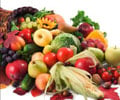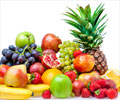Various colored fruits, vegetables, herbs, spices, legumes, and nuts offer us a plethora of phytonutrients.
Highlights:
- A rainbow of fruits and vegetables helps the body receive all the necessary nutrients
- Every colored fruit and vegetable is brimming with vital phytonutrients that support bodily functions and contribute to living a healthy lifestyle //
Health-promoting components of fruits and vegetables in the diet
Go to source).
In fact, these vibrantly colored fruits and vegetables are the richest in vitamins, minerals, fiber, and antioxidants, and top nutritionists always recommend eating a variety of fruits and vegetables. This isn't merely to make the plate seem great. Each color indicates a different vitamin that our bodies need.
What Does Each Color do for our Body and our Overall Health?
Red: The Color of Antioxidants
Red fruits and vegetables, including tomatoes, apples, cherries, watermelon, red grapes, strawberries, and capsicum, are colored by a type of phytonutrient called ‘carotenoids.’ These carotenoids act as natural antioxidants for the body (2✔ ✔Trusted SourceCarotenoids and their isomers: color pigments in fruits and vegetables
Go to source).
These anti-oxidants act as ‘free radicals’ that are formed naturally in our body as a byproduct of all our usual bodily processes, such as breathing and moving, but they also come from UV light exposure, smoking, air pollutants, and industrial chemicals.
Free radicals are unstable molecules that can harm our body's proteins, cell membranes, and DNA. This natural but harmful process is referred to as 'oxidation' or 'oxidative stress.' This promotes ageing, inflammation, and diseases such as cancer and heart disease.
Importantly, antioxidants clears free radicals in our bodies. They stabilize free radicals, preventing them from causing damage, increasing your intake of antioxidants lowers oxidative stress and lowers your risk of several diseases, including arthritis, type 2 diabetes, heart disease, stroke, and cancer (3✔ ✔Trusted Source
Antioxidant Phytochemicals for the Prevention and Treatment of Chronic Diseases
Go to source).
Orange: A Vitamin Vision Source
Orange fruits and vegetables, like carrots, pumpkins, apricots, mandarins, oranges, and turmeric, also contain carotenoids, but slightly different ones from those in red veggies. These carotenoids are converted to vitamin A in our bodies, which is important for healthy eyes and good eyesight.Vitamin A is also an antioxidant that can target the parts of your body made of lipids (or fats), such as cell membranes, reducing the risk of cancer and heart disease (4✔ ✔Trusted Source
What is vitamin A and why do we need it?
Go to source).
Yellow: The Carotenoid Source
Yellow fruits and vegetables, which include apples, pears, bananas, lemons, and pineapple, contain carotenoids, but they also contain other phytonutrients that are particularly important for eye health and can decrease the risk of age-related macular degeneration, which leads to blurring of your central vision.These phytonutrients can also absorb UV light in your eyes, acting like a natural sunscreen for the eyes and protecting them from the damaging effects of the sun (5✔ ✔Trusted Source
Dietary sources of lutein and zeaxanthin carotenoids and their role in eye health
Go to source).
Green: The Carrier of Vitamin B9
Green fruits and vegetables, including avocados, Brussels sprouts, apples, pears, green tea, and leafy vegetables, contain many phytonutrients, including chlorophyll, catechins, epigallocatechin gallate, phytosterols, nitrates, and an important nutrient known as folate (or vitamin B9).Folate is recommended before pregnancy because it lowers the chance of neural tube abnormalities in newborns (such as spina bifida). Folate has been proven to stimulate healthy cell division and DNA synthesis, which aid in the development of the fetal nervous system during the first few weeks of pregnancy.
These also act as antioxidants and provide important benefits in keeping your blood vessels healthy, by promoting something called "vasodilation," making our blood vessels more elastic and flexible, allowing them to widen or dilate, improving blood circulation, and reducing blood pressure. It also aids in the prevention of heart and other vessel complications and diseases (6✔ ✔Trusted Source
Recent Developments in Folate Nutrition
Go to source).
Blue and Purple: The Antioxidant Pack
Other phytonutrients found in blue and purple vegetables include anthocyanins, resveratrol, tannins, and others. Blackberries, blueberries, figs, prunes, and purple grapes contain them.Anthocyanins contain antioxidant characteristics and thus help to reduce the risk of cancer, heart disease, and stroke, as explained under red fruits and vegetables (7✔ ✔Trusted Source
Recent Research on the Health Benefits of Blueberries and Their Anthocyanins
Go to source).
More recent evidence suggests that they may also help with memory. This is considered to happen via enhancing signaling between brain cells and allowing the brain to evolve and adapt to new knowledge (a process known as brain plasticity) (8✔ ✔Trusted Source
Blueberries Improve Neuroinflammation and Cognition differentially Depending on Individual Cognitive baseline Status
Go to source).
Brown and White: Ultimate Source of Flavone
Brown and white fruits and vegetables are colored by apigenin, luteolin, isoetin, and other phytonutrients known as "flavones." Foods containing them include garlic, potatoes, and bananas.Allicin is another phytonutrient present in foods of this color, particularly garlic. Antibacterial and antiviral activities have been demonstrated for allicin (9✔ ✔Trusted Source
Antimicrobial properties of allicin from garlic
Go to source).
The majority of this study is still in the lab, and there haven't been many clinical trials in humans, but lab-based studies have indicated it suppresses bacteria when grown under laboratory conditions.
Allicin has also been shown in systematic studies to normalize elevated blood pressure by inducing blood vessel dilatation (10✔ ✔Trusted Source
Potential of garlic (Allium sativum) in lowering high blood pressure: mechanisms of action and clinical relevance
Go to source).
How can I Increase my Intake of Fruits and Vegetables?
We obtain a ton of phytonutrients from colored fruit and vegetables, as well as from herbs, spices, legumes, and nuts. Promoting a variety of fruits and vegetables is an easy way to ensure that all age groups receive the greatest possible health benefits.But the majority of us don't consume the recommended daily servings of fruit and vegetables. Intake recommendations include the following:
- When purchasing fruits and vegetables, fill your shopping cart with a rainbow of colors (frozen varieties are absolutely fine)
- Give some unfamiliar fruits and veggies a try. The internet offers advice on numerous methods for cooking vegetables
- Purchase colorful versions of your usual produce, such as apples, grapes, onions, and lettuce.
- Consume the skins since they may have more phytonutrients than the flesh.
- Don't forget to include herbs and spices in your cooking because they are rich in phytonutrients and help vegetables taste better.
- Health-promoting components of fruits and vegetables in the diet - (https://pubmed.ncbi.nlm.nih.gov/23674808/)
- Carotenoids and their isomers: color pigments in fruits and vegetables - (https://pubmed.ncbi.nlm.nih.gov/21336241/)
- Antioxidant Phytochemicals for the Prevention and Treatment of Chronic Diseases - (https://pubmed.ncbi.nlm.nih.gov/26633317/)
- What is vitamin A and why do we need it? - (https://www.ncbi.nlm.nih.gov/pmc/articles/PMC3936685/)
- Dietary sources of lutein and zeaxanthin carotenoids and their role in eye health - (https://pubmed.ncbi.nlm.nih.gov/23571649/)
- Recent Developments in Folate Nutrition - (https://pubmed.ncbi.nlm.nih.gov/29477222/)
- Recent Research on the Health Benefits of Blueberries and Their Anthocyanins - (https://academic.oup.com/advances/article/11/2/224/5536953)
- Blueberries Improve Neuroinflammation and Cognition differentially Depending on Individual Cognitive baseline Status - (https://pubmed.ncbi.nlm.nih.gov/30772901/)
- Antimicrobial properties of allicin from garlic - (https://pubmed.ncbi.nlm.nih.gov/10594976/)
- Potential of garlic (Allium sativum) in lowering high blood pressure: mechanisms of action and clinical relevance - (https://www.ncbi.nlm.nih.gov/pmc/articles/PMC4266250/)
Source-Medindia
















